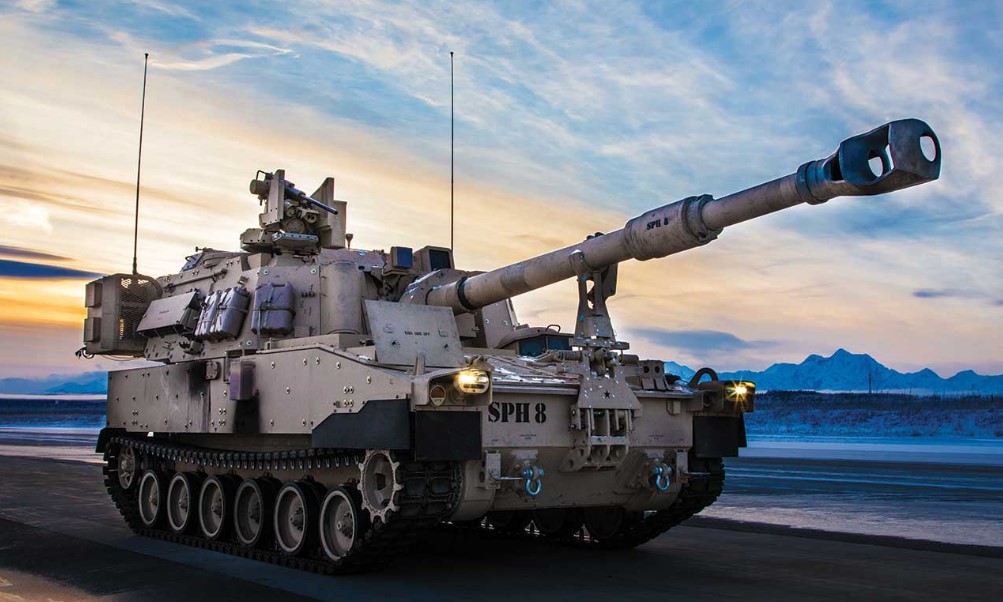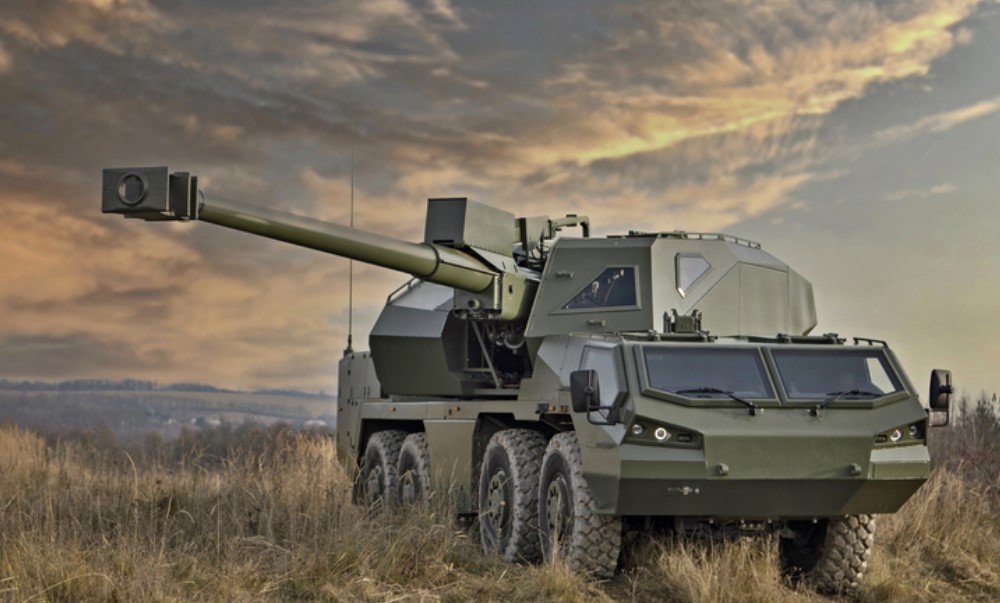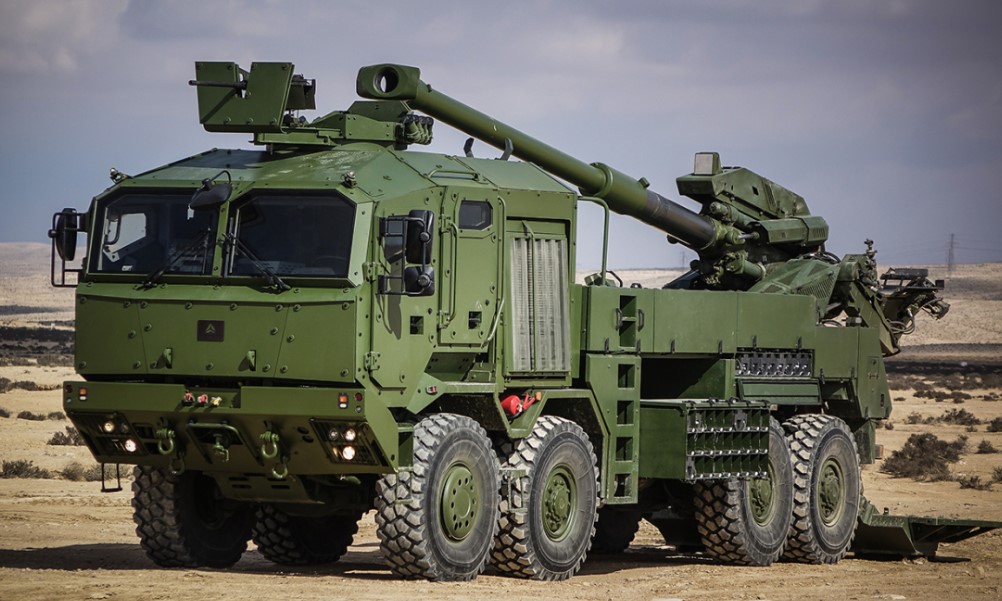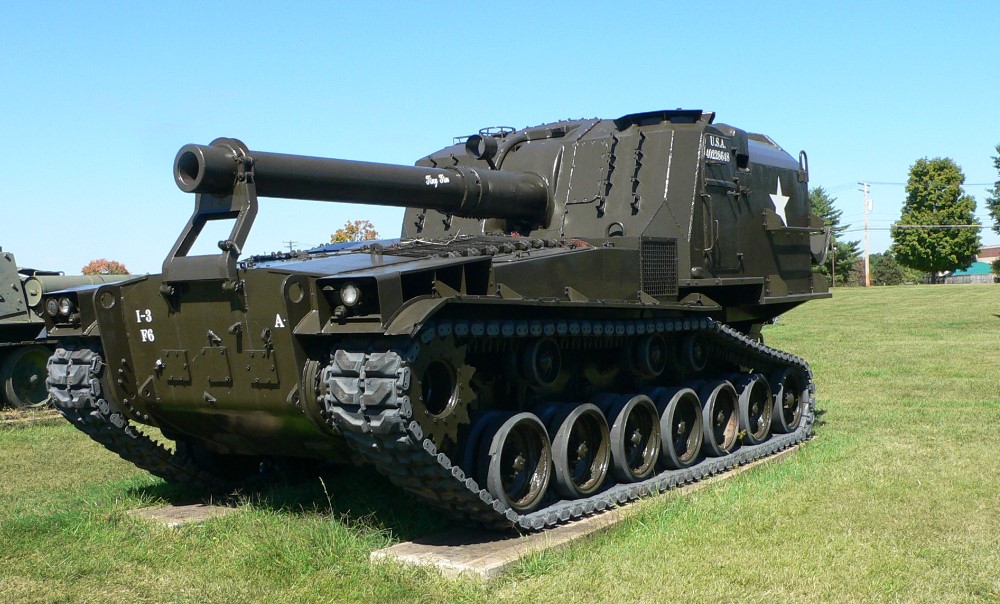An armored self-propelled howitzer (SPH) is a modern marvel of military technology that combines the destructive power of heavy artillery with the mobility of a tank. This combination of firepower, mobility, and protection makes it a critical asset in modern combat, capable of engaging enemy forces from a distance while providing protection for its crew. These vehicles are particularly important for providing rapid fire support in fluid and fast-changing battlefields.
What Is an Armored Self-Propelled Howitzer?

An armored self-propelled howitzer is essentially a large artillery gun mounted on a mobile, armored vehicle, usually tracked like a tank. This design allows the howitzer to move quickly across rough terrain, fire its artillery rounds, and reposition to avoid enemy counterattacks. Unlike traditional towed artillery pieces, self-propelled howitzers are fully autonomous, meaning they can move and operate without needing an external towing vehicle.
The main feature of these vehicles is their large-caliber gun, capable of firing explosive shells at high trajectories to hit targets miles away. This is why howitzers are primarily used for indirect fire, which allows them to support ground troops by bombarding enemy positions without needing to engage directly.
Modern SPHs are equipped with sophisticated targeting systems, advanced communications, and sometimes even GPS-guided ammunition to increase accuracy over long distances. The ability to move swiftly while firing powerful artillery shells provides a significant tactical advantage.
Key Features of Armored Self-Propelled Howitzers

Armored self-propelled howitzers (SPHs) are integral to modern artillery and military operations, offering a combination of heavy firepower, mobility, and protection. Below are the key features that make SPHs essential assets in warfare.
1. High Mobility
One of the defining characteristics of SPHs is their ability to move autonomously across various terrains. Whether equipped with tracks or wheels, SPHs can traverse difficult environments, such as mud, sand, and uneven terrain, enabling them to reach optimal firing positions and relocate swiftly after firing. This mobility is essential in avoiding counter-battery fire, a tactic in which the enemy targets the origin of artillery fire.
- Feature Highlight: Tracks or wheeled chassis for diverse terrain navigation
- Advantage: Quick repositioning and improved survivability on the battlefield
2. Heavy Firepower
SPHs are equipped with large-caliber guns, typically ranging from 155mm to 203mm, capable of firing high-explosive shells over long distances. These guns are designed for indirect fire, meaning they can target enemies beyond the line of sight. Modern SPHs often include automatic loading systems that significantly increase their rate of fire, delivering multiple rounds per minute.
- Feature Highlight: Large-caliber gun with automatic loading system
- Advantage: Long-range fire support with sustained high-volume fire rates
3. Advanced Fire Control Systems
Modern SPHs are equipped with sophisticated fire control systems, including computerized targeting and GPS-guided munitions. These systems allow for precise targeting, even when the howitzer is moving, and can calculate firing solutions based on real-time battlefield data. The integration of digital fire control systems minimizes human error and increases operational efficiency.
- Feature Highlight: GPS-guided munitions and digital fire control
- Advantage: Increased accuracy and reduced time to target
4. Armored Protection
The crew and critical systems of SPHs are housed in armored vehicles, providing protection from small arms fire, shrapnel, and indirect artillery fire. This allows SPHs to operate closer to the front lines than traditional towed artillery. Some models also feature NBC (Nuclear, Biological, Chemical) protection, ensuring the crew’s safety in hazardous environments.
- Feature Highlight: Armored chassis with optional NBC protection
- Advantage: Enhanced survivability in hostile environments
5. Self-Propelled Autonomy
SPHs do not require towing, unlike traditional artillery, which allows them to be quickly deployed and moved without external vehicles. This self-propelled feature gives them operational autonomy, improving flexibility during rapid advances or retreats in dynamic combat scenarios.
- Feature Highlight: Independent propulsion system
- Advantage: Greater tactical flexibility and reduced logistical support requirements
Detailed Benefits of Armored Self-Propelled Howitzers

- Unmatched Mobility and Agility
- Unlike stationary or towed artillery, SPHs can reposition themselves rapidly during a battle, allowing them to respond to changing combat conditions. This mobility means that an SPH can move closer to the battlefield, deliver devastating strikes, and quickly retreat or change positions to avoid incoming fire. Their mobility is particularly useful in situations where enemy forces employ counter-battery tactics (attempting to destroy artillery after it fires).
- Firepower for All Conditions
- With massive, long-barrel guns, SPHs can deliver high-explosive shells over long distances. Depending on the model and ammunition, these vehicles can engage targets from 30 to 70 kilometers away, covering wide areas and delivering heavy damage to enemy troops, armor, and fortifications. The large-caliber shells used by these vehicles can vary, with options ranging from high-explosive rounds designed to destroy infantry and buildings, to armor-piercing rounds that can penetrate heavily fortified positions.
- Operational Flexibility
- SPHs are flexible units that can operate across a wide range of battlefield conditions. Their armor provides protection from small arms fire and artillery shrapnel, allowing them to operate closer to the front lines than traditional artillery. Some models are also equipped with NBC (nuclear, biological, chemical) protection systems, which allow them to operate in hazardous environments, such as in the event of chemical warfare or nuclear fallout.
- Improved Crew Safety
- The armored design of the self-propelled howitzer protects the crew from small arms fire and shrapnel, making it safer than traditional towed artillery units. The crew operates inside the armored vehicle, which shields them from most battlefield dangers, including indirect enemy fire. Some models are even designed to protect the crew from direct hits from enemy tanks and anti-armor weapons, increasing the survivability of the unit in contested environments.
Top 5 Armored Self-Propelled Howitzers

In this section, we take an in-depth look at five of the top armored self-propelled howitzers available today. Each of these howitzers is highly regarded for its performance, mobility, and unique features.
- PzH 2000
The PzH 2000, produced by Krauss-Maffei Wegmann, is widely considered the most advanced self-propelled howitzer in the world. With an incredible range of up to 67 km, this howitzer features an automatic shell handling system, which significantly improves its fire rate to an impressive 10 rounds per minute.Key Features:- Range: 67 km
- Fire Rate: 10 rounds per minute
- Features: Automatic shell handling, modular armor, GPS-guided rounds.
- Price: Approximately $4.5 million
Its fast fire rate, combined with precise GPS-guided munitions, makes the PzH 2000 a versatile asset on any battlefield, capable of providing sustained fire support over long engagements.
- M109A7 Paladin
The M109A7 Paladin is a more traditional design, having been used by the U.S. Army for decades. However, the A7 version is a significant modernization of the system. Its range can be extended up to 70 km with certain types of ammunition, and it features digitized fire control for increased accuracy.Key Features:- Range: 30 km (upgradable to 70 km)
- Fire Rate: 4 rounds per minute
- Features: Digitized fire control, automation of operations, improved survivability.
- Price: Approximately $3.4 million
The M109A7’s emphasis on automation and digital control systems means it can operate more efficiently with a smaller crew.
- K9 Thunder
Developed by Hanwha Defense, the K9 Thunder is one of the most widely used self-propelled howitzers in the world. Known for its rapid deployment and ability to traverse difficult terrain, the K9 Thunder is equipped with NBC protection systems, making it highly adaptable in hazardous environments.Key Features:- Range: 40 km
- Fire Rate: 6-8 rounds per minute
- Features: High mobility, NBC protection, fast deployment.
- Price: Approximately $5 million
The K9 Thunder’s ability to maintain a high fire rate while remaining mobile is a key reason for its popularity among global militaries.
- CAESAR 8×8
The CAESAR 8×8, developed by Nexter Systems, is unique in that it’s mounted on a wheeled 8×8 chassis, making it more lightweight and mobile than many of its tracked counterparts. Despite its lighter design, it still packs a punch, with a range of 42 km and a fire rate of 6 rounds per minute.Key Features:- Range: 42 km
- Fire Rate: 6 rounds per minute
- Features: Lightweight, highly mobile, digital fire control system.
- Price: Approximately $2.5 million
Its wheeled design allows for rapid road deployment, making it ideal for missions requiring quick setup and movement.
- ATMOS 2000
The ATMOS 2000 is a self-propelled howitzer mounted on an 8×8 truck chassis. Produced by Elbit Systems, it’s designed for high mobility and is ideal for environments that require artillery to move quickly between different positions.Key Features:- Range: 40 km
- Fire Rate: 5 rounds per minute
- Features: Mounted on an 8×8 truck, adaptable to various terrains, rapid deployment.
- Price: Approximately $2.8 million
The ATMOS 2000’s truck-mounted design allows it to operate effectively on roads, making it a versatile option for armies that prioritize mobility.
Comparison Table: Top 5 Armored Self-Propelled Howitzers
| Model | Manufacturer | Range (km) | Fire Rate (RPM) | Features | Price (Approx.) |
|---|---|---|---|---|---|
| PzH 2000 | Krauss-Maffei Wegmann | 67 | 10 | Automatic shell handling, GPS rounds | $4.5M |
| M109A7 Paladin | BAE Systems | 30-70 | 4 | Digitized fire control, automation | $3.4M |
| K9 Thunder | Hanwha Defense | 40 | 6-8 | NBC protection, fast deployment | $5M |
| CAESAR 8×8 | Nexter Systems | 42 | 6 | Lightweight, highly mobile | $2.5M |
| ATMOS 2000 | Elbit Systems | 40 | 5 | Mounted on an 8×8 truck, rapid mobility | $2.8M |
Detailed Use Cases: Why You Need an Armored Self-Propelled Howitzer
- Providing Mobile Artillery Support:
Armored self-propelled howitzers are perfect for battlefield situations that require rapid fire support. Whether you’re engaging enemy infantry, tanks, or fortified positions, an SPH can be quickly deployed to the front lines and provide sustained artillery support. - Repositioning to Avoid Counterattacks:
One of the key advantages of self-propelled howitzers over towed artillery is their ability to move quickly after firing. This makes them much harder for the enemy to target with counter-battery fire, improving their survivability in contested areas. - Operating in Hostile Environments:
With their armored design and advanced NBC protection systems, SPHs can operate in hazardous environments where traditional artillery units would be vulnerable. This makes them essential in modern warfare, where chemical or nuclear threats may be present. - Supporting Urban and Open Field Combat:
SPHs are highly versatile, capable of operating effectively in both urban and open field environments. Their ability to deliver high-explosive rounds over long distances makes them valuable for a wide range of tactical operations, from city sieges to rural firefights.
How to Buy an Armored Self-Propelled Howitzer
Purchasing an armored self-propelled howitzer is a complex process that typically involves government contracts and military procurement channels. Here’s how to go about acquiring one:
- Reach Out to the Manufacturer:
Contact the official sales departments of manufacturers like Krauss-Maffei Wegmann, BAE Systems, and Hanwha Defense to start the conversation. - Request a Customized Quote:
The cost of an SPH can vary widely depending on the model and specific configuration. Be sure to discuss the options for additional armor, advanced fire control systems, and upgrades like GPS-guided ammunition. - Understand Procurement Regulations:
In most countries, purchasing military-grade equipment requires governmental approval. You’ll need to follow strict procurement regulations and ensure you meet all legal requirements for the acquisition. - Explore Financing and Contracts:
Because these vehicles are expensive (ranging from $2.5M to $5M), many military procurement processes involve long-term contracts or financing options, often negotiated directly with manufacturers or through defense budgets.
FAQs
- What is the typical range of a self-propelled howitzer?
Most self-propelled howitzers have a range of 30 to 70 km, depending on the model and the type of ammunition used. - How does a self-propelled howitzer differ from a traditional towed howitzer?
A self-propelled howitzer is mounted on an armored vehicle, allowing it to move on its own, whereas a towed howitzer requires a separate vehicle for transportation. This gives self-propelled howitzers much greater mobility. - Can civilians buy armored self-propelled howitzers?
No, these vehicles are restricted to military use and government-approved contractors. Civilians cannot purchase these weapons. - What is the fire rate of a self-propelled howitzer?
Fire rates vary between models, but most modern SPHs can fire between 4 to 10 rounds per minute, depending on their automation and handling systems. - What kind of maintenance is required for a self-propelled howitzer?
Regular maintenance is essential for ensuring the reliability of an SPH. This includes engine maintenance, calibration of the fire control systems, and periodic checks of the vehicle’s armor and artillery systems.